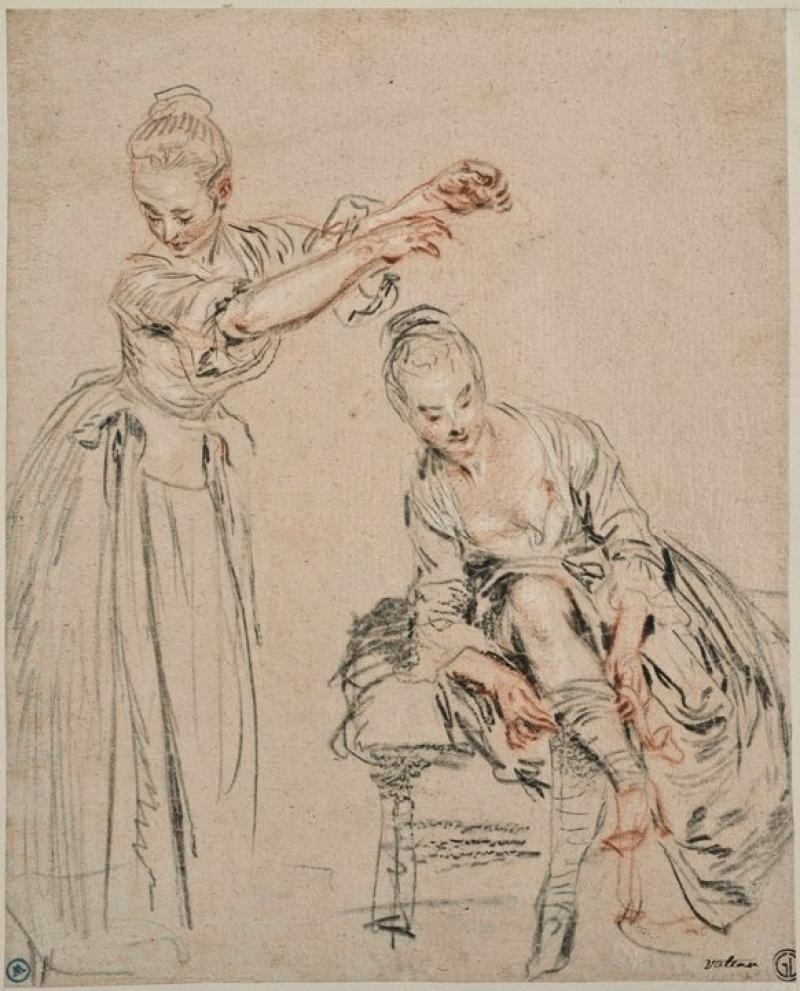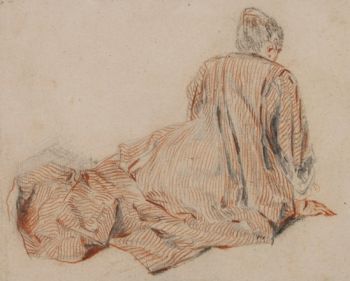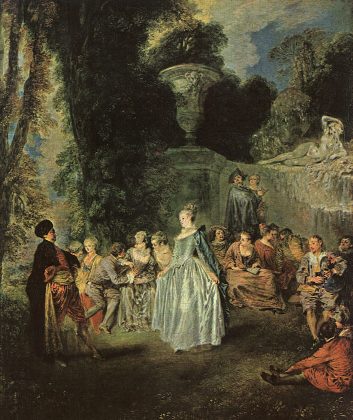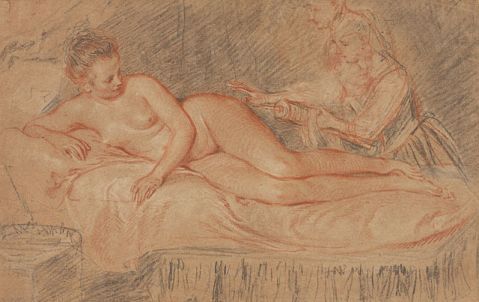Antoine Watteau, Royal Academy and Wallace Collection | reviews, news & interviews
Antoine Watteau, Royal Academy and Wallace Collection
Antoine Watteau, Royal Academy and Wallace Collection
Eighteenth-century French painter wows us with exquisite drawings

As a young man searching for a way to make a living in Paris, Antoine Watteau briefly tried his hand at engraving fashion plates. He seems to have had a natural affinity for cloth and drew its folds and creases with such apparent ease that you can almost feel the slipperiness of satin and hear the rustle of taffeta as it moves with the body. This was just as well, since he didn’t attend the Academy where students did life drawing and learned anatomy.
One of the most beautiful drawings in the Royal Academy’s superb exhibition is of a woman sitting on the ground with her back to us (pictured below: Woman Seen from the Back Seated on the Ground, Leaning Forward, c 1717-18, British Museum). Her stripey dress covers her body completely, yet every detail of her posture is made clear as the cloth flows down her back and crumples and furls around her buttocks, legs, feet and arms.
 Tender drawings of young women show their hair swept up and held in place by hats, berets or strange head gear resembling horns. Draped in black, a young woman rests on what could be a tomb, her eyes rimmed with red as though she has been crying. In 1715 a delegation from Persia visited France and Watteau was able to draw the exotic guests in their ikat silks and huge turbans. These are not just sketches; drawing incessantly, Watteau built up an image bank for use in his paintings and prized his portfolio more highly than his paintings. Red chalk gives the images enormous warmth and vitality, black chalk provides weight and emphasis while subtlety is achieved with touches of graphite and occasional highlights in white.
Tender drawings of young women show their hair swept up and held in place by hats, berets or strange head gear resembling horns. Draped in black, a young woman rests on what could be a tomb, her eyes rimmed with red as though she has been crying. In 1715 a delegation from Persia visited France and Watteau was able to draw the exotic guests in their ikat silks and huge turbans. These are not just sketches; drawing incessantly, Watteau built up an image bank for use in his paintings and prized his portfolio more highly than his paintings. Red chalk gives the images enormous warmth and vitality, black chalk provides weight and emphasis while subtlety is achieved with touches of graphite and occasional highlights in white.
The cast of characters includes musicians and dancers; Savoie peasants and shoe-shine boys plying their trade on the streets of Paris; portraits of friends – artists, collectors and dealers – and models posing in their own clothes or wearing items from a wardrobe of costumes for characters including Harlequin and Pierrot from the commedia dell’arte. When it came to creating a painting, Watteau searched through the drawings choosing young women or gallants from one page and dancers or musicians from another, then arranging them on canvas in gossipy clusters, often modifying their poses to make the groups convincing.
 Once you’ve seen the drawings, then, you can identify many of the characters in the paintings exhibited in Watteau and His Circle at the Wallace Collection. Stylish Parisians rub shoulders with imaginary people in luxurious gardens inspired both by Renaissance paintings and the Jardin du Luxembourg. It may be hard for us to distinguish fashion à la mode from theatre costumes or 17th-century dress, but it's still obvious that scenes like Fêtes Vénitiennes, 1719 (pictured left), from the collection of Watteau’s dealer Jean de Jullienne, are a heady mix of fantasy and reality. A couple dances a minuet in front of a party of musicians and fashionable youngsters in an Italianate garden resembling a theatre set with a painted backdrop. The title refers to a popular opera-ballet by Antoine Danchet, yet the cast includes Watteau (on bagpipes) and his painter friend Nicolas Vleughels as the male dancer so, as usual, the scene encompasses an ambiguous mixture of fact and fiction.
Once you’ve seen the drawings, then, you can identify many of the characters in the paintings exhibited in Watteau and His Circle at the Wallace Collection. Stylish Parisians rub shoulders with imaginary people in luxurious gardens inspired both by Renaissance paintings and the Jardin du Luxembourg. It may be hard for us to distinguish fashion à la mode from theatre costumes or 17th-century dress, but it's still obvious that scenes like Fêtes Vénitiennes, 1719 (pictured left), from the collection of Watteau’s dealer Jean de Jullienne, are a heady mix of fantasy and reality. A couple dances a minuet in front of a party of musicians and fashionable youngsters in an Italianate garden resembling a theatre set with a painted backdrop. The title refers to a popular opera-ballet by Antoine Danchet, yet the cast includes Watteau (on bagpipes) and his painter friend Nicolas Vleughels as the male dancer so, as usual, the scene encompasses an ambiguous mixture of fact and fiction.
Such was Watteau’s success that the Academy was forced to welcome him into their ranks; for his flirtatious scenes they created the special category of “fêtes galantes” – festivities by decent folk. His folk may behave decorously enough, but the presence of a lascivious subplot is revealed by seductive statuary that looks suspiciously like flesh rather than marble. The lovers may keep their clothes on, but the artist has obviously had access to naked models.
It turns out that his friend and biographer the comte de Caylus, who was an amateur artist, held life-drawing sessions “in the rooms I had in different quartiers of Paris”. Prefiguring Degas by some 150 years, Watteau produced some wonderfully intimate drawings of a model dressing. Before he died of tuberculosis in 1721, at the horribly young age of 37, he destroyed most of his nudes since they were considered indecent; but thankfully, a few survived. The Remedy (pictured below, courtesy of J Paul Getty Museum) is filled with double entendres. A young woman reclines on a bed, her body outlined in red chalk that makes her look red hot. Her maid kneels behind her, one hand hovering over her mistress’s haunch, the other holding a phallic syringe; she is about to administer a remedy for this overheating – an enema!

Even titillating scenes like this have an unusual dignity. Watteau’s paintings are often described as wistful or melancholic and, by all accounts, the artist was introverted and shy, perhaps because he was an outsider. He was working class (his father was a roofer), came to Paris at the age of 18 from Valenciennes, a part of Flanders recently annexed by France, and had to make his way outside establishment circles dominated by the Academy. He didn’t even have a settled domestic life or studio, but roamed from one lodging to another with a restlessness that must surely have been exacerbated by his illness.
Click to enlarge images
- Seated Persian Wearing a Fur Hat, 1715 (Teylers Museum, Haarlem)
- Standing Savoyard, c 1715 (Art Institute of Chicago, Helen Regenstein Collection)
- Three Studies of a Young Girl Wearing a Hat, c 1716 (Collection of Ann and Gordon Getty)
- Woman Wearing a Mantle Over Her Head and Shoulders, c 1718-19 (Sterling and Francine Clark Art Institute, Williamstown, Massachusetts)
[bg|/ART/Sarah_Kent/Watteau]
In his work, this sense of transience translates into an extraordinary degree of empathy; his people are minutely observed, but are never merely specimens. They seem to have an inner life, a degree of introspection that is rare in paintings and reminds one of Rembrandt’s subjects. Given that Watteau’s paintings are easily dismissed as frivolous because they are small and their subject matter seemingly slight, this quiet intensity is remarkable. Rather than simply being escapist trifles, these little gems turn out to contain a rather profound message; no matter how many diversions you indulge in – whether dancing, singing, flirting or the theatre – you will always remain alone and be irredeemably mortal.
- Watteau: the Drawings at the Royal Academy until 5 June
- Esprit et Vérité: Watteau and His Circle (admission free) at the Wallace Collection until 5 June
Share this article
The future of Arts Journalism
You can stop theartsdesk.com closing!
We urgently need financing to survive. Our fundraising drive has thus far raised £49,000 but we need to reach £100,000 or we will be forced to close. Please contribute here: https://gofund.me/c3f6033d
And if you can forward this information to anyone who might assist, we’d be grateful.

Subscribe to theartsdesk.com
Thank you for continuing to read our work on theartsdesk.com. For unlimited access to every article in its entirety, including our archive of more than 15,000 pieces, we're asking for £5 per month or £40 per year. We feel it's a very good deal, and hope you do too.
To take a subscription now simply click here.
And if you're looking for that extra gift for a friend or family member, why not treat them to a theartsdesk.com gift subscription?
more Visual arts
 'We are bowled over!' Thank you for your messages of love and support
Much-appreciated words of commendation from readers and the cultural community
'We are bowled over!' Thank you for your messages of love and support
Much-appreciated words of commendation from readers and the cultural community
 Photo Oxford 2025 review - photography all over the town
At last, a UK festival that takes photography seriously
Photo Oxford 2025 review - photography all over the town
At last, a UK festival that takes photography seriously
![SEX MONEY RACE RELIGION [2016] by Gilbert and George. Installation shot of Gilbert & George 21ST CENTURY PICTURES Hayward Gallery](https://theartsdesk.com/sites/default/files/styles/thumbnail/public/mastimages/Gilbert%20%26%20George_%2021ST%20CENTURY%20PICTURES.%20SEX%20MONEY%20RACE%20RELIGION%20%5B2016%5D.%20Photo_%20Mark%20Blower.%20Courtesy%20of%20the%20Gilbert%20%26%20George%20and%20the%20Hayward%20Gallery._0.jpg?itok=7tVsLyR-) Gilbert & George, 21st Century Pictures, Hayward Gallery review - brash, bright and not so beautiful
The couple's coloured photomontages shout louder than ever, causing sensory overload
Gilbert & George, 21st Century Pictures, Hayward Gallery review - brash, bright and not so beautiful
The couple's coloured photomontages shout louder than ever, causing sensory overload
 Lee Miller, Tate Britain review - an extraordinary career that remains an enigma
Fashion photographer, artist or war reporter; will the real Lee Miller please step forward?
Lee Miller, Tate Britain review - an extraordinary career that remains an enigma
Fashion photographer, artist or war reporter; will the real Lee Miller please step forward?
 Kerry James Marshall: The Histories, Royal Academy review - a triumphant celebration of blackness
Room after room of glorious paintings
Kerry James Marshall: The Histories, Royal Academy review - a triumphant celebration of blackness
Room after room of glorious paintings
 Folkestone Triennial 2025 - landscape, seascape, art lovers' escape
Locally rooted festival brings home many but not all global concerns
Folkestone Triennial 2025 - landscape, seascape, art lovers' escape
Locally rooted festival brings home many but not all global concerns
 Sir Brian Clarke (1953-2025) - a personal tribute
Remembering an artist with a gift for the transcendent
Sir Brian Clarke (1953-2025) - a personal tribute
Remembering an artist with a gift for the transcendent
 Emily Kam Kngwarray, Tate Modern review - glimpses of another world
Pictures that are an affirmation of belonging
Emily Kam Kngwarray, Tate Modern review - glimpses of another world
Pictures that are an affirmation of belonging
 Kiefer / Van Gogh, Royal Academy review - a pairing of opposites
Small scale intensity meets large scale melodrama
Kiefer / Van Gogh, Royal Academy review - a pairing of opposites
Small scale intensity meets large scale melodrama
 Jenny Saville: The Anatomy of Painting, National Portrait Gallery review - a protégé losing her way
A brilliant painter in search of a worthwhile subject
Jenny Saville: The Anatomy of Painting, National Portrait Gallery review - a protégé losing her way
A brilliant painter in search of a worthwhile subject
 Abstract Erotic, Courtauld Gallery review - sculpture that is sensuous, funny and subversive
Testing the boundaries of good taste, and winning
Abstract Erotic, Courtauld Gallery review - sculpture that is sensuous, funny and subversive
Testing the boundaries of good taste, and winning
 Edward Burra, Tate Britain review - watercolour made mainstream
Social satire with a nasty bite
Edward Burra, Tate Britain review - watercolour made mainstream
Social satire with a nasty bite
